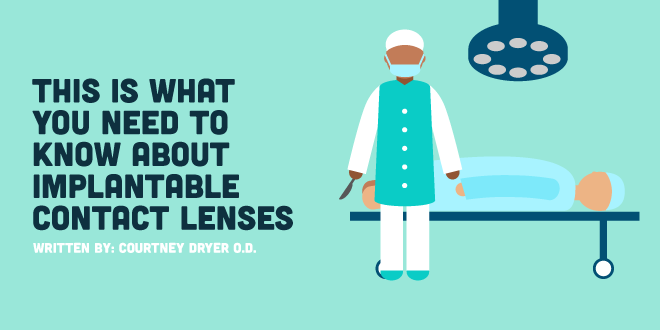What is an implantable contact lens?
- A Visian Implantable Collamer Lens is planted behind the iris, but in front of the crystalline lens
- Made of Collamer that is naturally found within the body
- Corrects for the spherical component of the refraction
- In contrast to IOLs, Visian lenses can be folded and inserted through smaller incision sites without the need for sutures
- 95% of patients had vision of 20/40 or better
- Procedure is reversible and the lenses can be removed if patient is unsatisfied
- Has been approved in the states since 2005, with over 500,00 implants by surgeons completed
- Corrects myopia from -3.00 – -20.00 Diopters¹
Who is a good candidate?
- HIGH MYOPES!
- Patients between the ages of 21-45
- Patients with little or no astigmatism
- Patients with average or thin corneal thickness who may not be Lasik or PRK candidates
- Patients with sufficient large anterior chamber depth
- Patients with acceptable endothelial cell density
- Stable refractions with less then 0.50 diopters of change in two years
- Dry eye patients¹
Advantages of ICL vs Lasik
- Reversible
- No permanent changes made to the eye
- Less chance of regression for high myopes
- Correction for higher amounts of myopia
- No risk of corneal ectasia
- No risk of flap-related issues¹
Advantages of ICL vs PRK
- Quicker rate of recovery post surgery
- Correction for higher amounts of myopia¹
Patient Education
- Education on patient expectations for the iridotomy, possible headache, light sensitivity, and dull discomfort
- Risks are similar to cataract surgery: retinal detachments, macular edema, increased intraocular pressure, endophthalmitis
- Cataracts can be caused if surgeon touches the patient’s lens during surgery
- Halos my be increased due to iridotomy in low light conditions
Surgical Process
O.D. Co-management Care
- Typically the ophthalmologist will follow-up 24 hours after the surgery to ensure intraocular pressure has not become elevated
- OD co-management may vary per surgeon, consult with your local surgeon for their preferred protocol
- ODs will be asked to document lens “vaulting” which is directly correlated to the size of ICL implanted²
Judging the “vault” of the lens is done by using a narrow slit lamp beam on the cornea and comparing the dark space between the ICL and the lens. Ideal vault is between 250-850 microns.
Vaulting
- Measurement is important for post-operative conditions like pupil block, IOP elevation, and iridotomy occlusion²
- Inadequate vault can lead to PSC cataracts and overvaulting can lead to increase in IOP²
- Picture C shows a vault of 50% while picture D has a vault of 200%²
What’s new?
“…210 eyes in 124 patients with a mean myopia of -9.37D and a mean astigmatism of +1.95D and an average age of 35. 12-month clinical outcomes show that 82% of the eyes were 20/20 or better uncorrected and 54% of the eyes were 20/16 or better.” ¹
- ICL, Visian. “Visian ICL.” Visian ICL. Staar Surgical Company, 2006. Web. 11 Nov. 2015. <http://visianinfo.com>.
- Slade, Stephen, MD, and Richard Baker, MD. “LATEST ARTICLES.” A Surgeon’s Perspective on ICL: Implantable Collamer Lens. Slide & Baker Vision Center, 20 Aug. 2012. Web. 18 Nov. 2015. <https://www.visiontexas.com/houston/blog/detail/2012/08/20/a-surgeon-s-perspective-on-icl-implantable-collamer-lens.html>.
